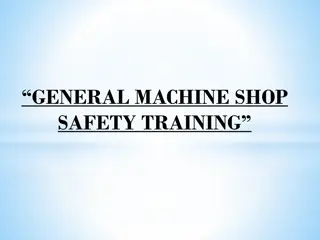Machine Shop Safety Guidelines
Training safety guidelines for machine guarding, inspections, maintenance, recordkeeping, and emergency response protocols are crucial for a safe machine shop environment. The presentation emphasizes the importance of following general shop safety and housekeeping practices, maintaining clear egress paths, wearing proper personal protective equipment (PPE), and adhering to safety procedures while operating machinery. It stresses the need for vigilance, focus, and adherence to safety measures in machine shop operations.
Download Presentation

Please find below an Image/Link to download the presentation.
The content on the website is provided AS IS for your information and personal use only. It may not be sold, licensed, or shared on other websites without obtaining consent from the author.If you encounter any issues during the download, it is possible that the publisher has removed the file from their server.
You are allowed to download the files provided on this website for personal or commercial use, subject to the condition that they are used lawfully. All files are the property of their respective owners.
The content on the website is provided AS IS for your information and personal use only. It may not be sold, licensed, or shared on other websites without obtaining consent from the author.
E N D
Presentation Transcript
Training Safety Guidelines Machine Guarding OVERVIEW Inspections and Maintenance / Recordkeeping Emergency Response Protocol
TRAINING REQUIREMENTS Review UNCs Machine Shop Program for more information on the contents of this presentation. The shop supervisor will complete: General Shop Information Training: Provides basic contact information to those using the shop, it must be reviewed by all shop users. General Shop Safety Training: Must be conducted for each employee using the shop.
SAFETY GUIDELINES HOUSEKEEPING Keep surfaces free of dirt, wood, metal chips, sawdust, oil, grease, and other debris. Cease operations of machinery before cleaning or performing maintenance. Use a brush to remove chips and a cloth to clean oily surfaces. Never use compressed air to clean off skin or clothing. Store materials in such a way to prevent falling, slipping, or rolling.
EGRESS Do not store materials on the floor or in any place where they may impede egress from the area. SAFETY GUIDELINES Position equipment in such a way that allows for a clear and safe operating space for each machine. All exits shall be properly identified with signage.
SAFETY GUIDELINES Personal Protective Equipment (PPE) Wear safety glasses at all times when equipment is in use. Some tasks and equipment types may require additional PPE. Always ensure there is sufficient ventilation for welding and cutting areas. Wear the proper respirator (the one you have passed a fit test with) when the task requires it. Close toed shoes and clothing that covers the legs are required. Consider toe reinforcement if your work includes heavy objects. Wear ear plugs! Even when not required, ear plugs will help you tremendously in the long run. If you are unsure about the right PPE for your job, don t hesitate to ask your supervisor or call EHS! We re here to help.
SAFETY GUIDELINES Safety Procedures Loose clothing and jewelry should not be worn when operating equipment. Long hair should be tied back to prevent entanglement. Do not wear gloves around moving machinery. Keep your body parts away from the point of operation, use devices to manipulate materials at the point of operation. Never attempt to move at a faster or slower pace than a machine is designed for. Be diligent when working in a machine shop, always focus on the task at hand. Remember safety starts with you! This isn t an exhaustive list of safety measures for your specific task.
MACHINE GUARDING EVERY machine must be outfitted with the proper guards and shields as per manufacturers requirements. A guard/shield should never be removed, changed, or modified in any way. Check the user manual for the specific machine you are using. A basic machine guarding reference guide is available from the EHS Department. If you feel that a guard in place causes more of a hazard than it protects against, bring this issue up with your supervisor or EHS.
INSPECTIONS Both supervisors and equipment users will have roles for inspections!
SUPERVISOR INSPECTIONS The shop supervisor should complete an inspection of each shop in quarterly intervals. Remove equipment from service that is unsafe or not operating in conformance with the manufacturer s guidelines. A Machine Shop Inspection Checklist is available from EHS as part of the Machine Shop Program.
USER (PRE-USE) INSPECTIONS Pre-Use inspections cut down the amount of costly repairs and long downtimes from chronic problems in machines, they also reduce the risk of injury to workers! Walk completely around the machine, visually inspect all parts before use to ensure that they are in a safe, operational condition. Make this a routine, be consistent and do it the same way every time. It will be easier to spot when things are out of the ordinary with a machine. Report any damaged or defective equipment to your supervisor immediately!
Recordkeeping is an important part of the inspection process. Supervisors should document and maintain a record of their inspections as well as all training administered to employees. RECORDKEEPING
EMERGENCY RESPONSE PROTOCOLS Important information for both minor and life-threatening emergencies.
MINOR INJURIES Regardless of the severity, any injury should be immediately reported to the shop supervisor. Be aware the location of emergency equipment in every shop you work in. This includes: First Aid Kit Eye Wash / Emergency Shower Fire Extinguisher Emergency Shutoff This information is displayed in the General Shop Information form. Ask the supervisor for assistance in completing an incident report form.
LIFE-THREATENING INJURIES Be aware the location of the shop telephone (if available) in every shop you work in. Life-threatening emergencies include: Amputations Head injury Uncontrolled bleeding Large cuts Impalement In case of a life-threatening emergency, dial 911 right away. Don t wait!
QUESTIONS? Thank you for attending this presentation!
































